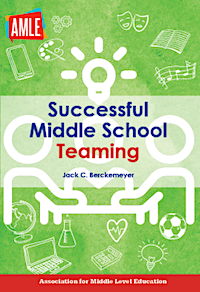10 Snapshots of Effective Middle School Teams
Jack Berckemeyer is a legendary leader of the middle school movement and an expert on interdisciplinary teaming.
By Jack Berckemeyer
 How successful is your middle school team? Are you accomplishing the team’s goals for your students? Can you see the difference that teaming makes for the kids?
How successful is your middle school team? Are you accomplishing the team’s goals for your students? Can you see the difference that teaming makes for the kids?
Do you experience the positive power of the interdisciplinary teaming process? Or is your process less than powerful and effective? Does it seem that you never have enough time to meet, or that your meetings are not productive?
Maybe your meeting time gets eaten up with housekeeping details. Or is most of your team time, perhaps, spent griping about the kids (or their families)? Do you use up large blocks of time discussing the same few kids over and over?
Maybe you feel out of sync with your teammates and wish you didn’t have to meet at all. Or perhaps you even wonder why you are teaming in the first place.
Interdisciplinary teaming can work miracles
Over 40 years of research on successful middle schools has verified such amazing benefits of interdisciplinary teaming as these:
- students thriving in small, personalized communities where they enjoy an enhanced sense of belonging and security,
- making connections in skills and concepts across content areas,
- higher levels of achievement,
- greater adult advocacy for students,
- quality relationships, and
- consistent classroom procedures.
Quality teaming contributes to higher teacher morale and camaraderie, increases job satisfaction, and boosts professional growth. The teaming process also nourishes greater connection and communication with parents and caregivers.
I’ve worked for many years with teams – in schools of all kinds, sizes, and locations. Oh, the stories I could tell! I’ve seen every imaginable team configuration and personality, and have watched myriad sets of accomplishments, dysfunctions, joys, and pains.
Sometimes teams are teams in name only. The school creates teams; teams design snappy names, logos, and handshakes. But then teachers go their separate ways without much correlation in learning or consistency in expectations across classrooms. Yes, teaming can yield incredible outcomes for students. But these amazing benefits result only to the extent that teaming practices are effective and consistent over time.
I’ve learned plenty about what makes teams work well and what obstructs or completely derails good teaming. We all want those amazing benefits mentioned above from our teaming. So let’s take a look at some snapshots that show what a highly effective team looks like.
Snapshot #1. You’ll see team members getting along.
The adults on the team are fully committed to working together to build a healthy, high functioning team. (Truly, most of the team troubles I see in my work with teams boil down to a lack of attention to this.)
The team spends time getting to know each other – as persons and as educators. They accept and value each other – with all the individual personality quirks, teaching styles, and talents. They understand that their differences are part of their strength as a team.
Team members commit to communicate honestly and openly, to be flexible, to not hold grudges, to trust each other, and to be trustworthy. (Basically, great teams don’t worry about who ate their yogurt and why Ms. Smith keeps parking in your parking spot.)
Team members enjoy the team as a safe place to be themselves and express opinions. Each person has a voice in all plans, processes, or decisions. They listen to each other, welcoming one another’s contributions and taking them seriously. No one person runs the show or subverts the work.
This team realizes that they cannot accomplish good teaming processes for their students if the adults get wrapped up in petty squabbles, make power plays, or sabotage of each other or of the team’s purposes. So they don’t waste their time on pettiness. And every member faithfully honors the others’ privacy and confidentiality. What happens in the team, stays in the team.
Snapshot #2: You’ll see the team setting goals and working hard.
This team knows that their reason for being is to create and sustain the best possible academic, social, and emotional climate for their students. To fulfill this purpose, they know they need to grow and develop as professionals. And they acknowledge, up front, that this all takes work – serious, sustained work.
Members agree on what the work of the team is, and each member willingly participates equally in doing it. The team has crafted a clear set of beliefs and purpose; they’ve shared this in writing with students and their families.
This effective team has set priorities for its work together with such goals as keeping track of each student’s academic and social well-being, regularly monitoring student academic progress, sharing excellent instructional practices, coordinating student assignments and assessments, building strong relationships with students’ families, setting consistent procedures across the team, and regular, targeted team professional development.
Like all great teams, this group sets norms for how they will work together. But more importantly, they hold each other accountable to those norms. An agreed-upon decision-making process serves as their guide for handling plans and challenges. When a decision is needed or a crisis pops up, this team has something solid to rely on other than just giving in to whoever is the loudest or most stubborn team member. With a preplanned decision-making process, members are able to jointly honor and support team decisions.
Snapshot #3: You’ll see members cherishing team planning time and using it well.
Team planning sessions are only as useful as team members make them. Meetings can degenerate into gossip (or complaining) sessions, with members straggling in intermittently – looking mainly for the food. But this effective team highly values the time they have; each member shows up on time for all meetings; sets aside the many competing tasks, texts, and myriad other disruptions; and contributes actively. (No one is ordering dinner for the family, grading assignments, or catching up on email.)
Team members come prepared to share their individual classroom schedules; discuss specific student needs and data; plan upcoming cross-curricular focuses; share teaching successes, challenges, and ideas; learn something together; keep good records of actions and plans; and spend time encouraging one another. (Yes, they eat, too. As I always say: “Eating makes a meeting!”) And they consistently advocate with the school administration for adequate team planning time.
Snapshot #4: You’ll see the team following an agenda at every meeting.
The team never starts a meeting without a clear agenda. This assures that key, consistent topics are covered and keeps the meeting on track. It also serves as a record of the team’s work. And since this team is committed to following its agendas, they avoid wasting time – averting the chance that something (or someone) will pull the meeting off course.
This effective team has already agreed that agendas will include discussion of student needs and progress; time to share, coordinate, and plan academic activities; and regular professional development activities to strengthen team practices and instructional techniques. When needed, the agenda sets aside time for the team to meet with a student or parent. Each agenda also allows time to update the team calendar, record the decisions and plans made during the meeting, and attend to some housekeeping details.
Snapshot #5: You’ll see team members focusing firmly on the kids.
Lots of teams claim to be focused on kids. But just what does that mean? A focus on kids means that the team’s actions are all about doing what helps students thrive.
Snapshots of this team show that they have:
- Specific ways for all team members getting to know all the students,
- Regular checkups on kids’ academic, social, and personal progress and success – with immediate interventions when problems occur or kids slide,
- An advocacy process that matches each student with a specific adult advocate who keeps regular connection with the student, assuring that no kid falls through the cracks,
- Intentional practices that foster belonging and meaningful relationships.
You’ll find this team setting policies and practices that are student-centered, unbiased, and fairly implemented. For every action and decision, team members ask: “Is this good for the kids?” and “What will this contribute to greater success for the students?”
Download all 10 of Jack’s snapshots here
Snapshot #10: You’ll see a team learning and laughing.
The team knows that they grow best together. They self-evaluate honestly and boldly; they regularly plan short-term and long-term team PD activities to help them become better teachers and to strengthen team practices. This team does a lot of laughing. They commit to having some fun moments in every meeting – they plan a crazy question, quick game (“Would you rather….””), or sharing of cartoons or jokes about school life.
Team members enjoy and uplift each other. (And yes, they eat.) As they learn, laugh, and eat together, they find that wonderful things happen – frustrations ebb, tensions defuse, biases lessen, tight muscles relax, doubts ease, and trust grows.
There’s nothing quite like it
I could describe many more pictures of the effective team at work. The images would show energized teachers and engaged students fueled by the amazing power of good teaming. Teams can sharpen up their team beliefs, commitments, and effective practices to tap into that power. There’s nothing quite like it, for kids or teachers!

He is also the author of Managing the Madness: A Practical Guide to Middle Grades Classrooms; Taming of the Team: How Great Teams Work Together; How to Do Virtual Teaching Even If You Have a Face for Radio; The What, Why, and How of Student-Led Conferences; and co-author (with Debbie Silver) of Deliberate Optimism: Still Reclaiming the Joy in Education, 2nd Edition. Visit Jack’s website and follow him on X-Twitter.
































Jack Berckemeyer is “spot on” with his advice for teaming! Great teachers do not do it alone. The support of a strong team is essential to the well-being of individual teachers as well as an added benefit for the students. Thank you, Jack, for sharing your extensive experience and collected wisdom about what it takes to create effective school teams! Schools that have the privilege of working with you are lucky indeed!